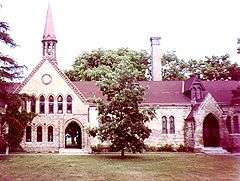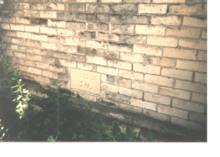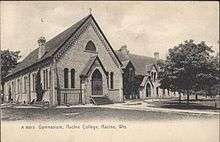Racine College
|
Racine College | |
|
Racine College's St. John's Chapel | |
| Location | 600 21st St., Racine, Wisconsin |
|---|---|
| Area | 40 acres (16 ha) |
| Built | 1876 |
| Architectural style | Gothic |
| NRHP Reference # | 76000076[1] |
| Added to NRHP | December 12, 1976 |





Racine College was an Episcopal preparatory school and college in Racine, Wisconsin, founded in 1852.[2] Most boys enrolled at Racine College were secondary (or grammar) school students preparing for the Bachelor of Arts course.
Racine College's most notable warden was the Rev. Dr. James DeKoven. DeKoven was a major exponent of High Church and Anglo-Catholic views in the Episcopal Church. One of the best-known preachers and orators of his day, he died in 1879 at age 49.
Racine was directly influenced - especially after DeKoven was elected Warden in 1856 - by the Grammar School and College of Saint James in Maryland, which in turn was part of the "Church school" movement inaugurated by William Augustus Muhlenberg and his proteges in 1828. When the American Civil War drove Saint James out of business, several important teachers and professors joined DeKoven at Racine. Racine College was sometimes called "the Sewanee of the North", since both were Oxonian-like, church-operated institutions. The grammar school and college at Sewanee, Tennessee were closely linked to Racine in the postbellum era; the Chancellor of the University of the South, Bishop Charles Todd Quintard, served on the Racine Board of Trustees, and an early leader of Sewanee, Thomas F. Gailor, was prepared at Racine.[3]
When DeKoven began to raise money for new buildings at Racine College, he looked to England for his inspiration. Most of the campus buildings were inspired by the architecture of St. Peter's College, a high-church public school founded at Radley in 1847.
Racine and the University of Michigan inaugurated college football in the Midwest with a match played on May 30, 1879. Michigan won, 1–0.[4]
Excerpt from 1858 Racine City Directory: Racine College
Faculty. – Rev. Roswell Park, D. D., President, and Professor of Mathematics and Natural Philosophy; Rev. Joseph H. Nichols, A. M., (Chicago,) Professor of English Literature; Rev. George Cowell, A. M., Acting Professor of the Greek and Latin Languages; Marshall M. Strong, Esq., A. M., Lecturer on Legal Science; Philo R. Hoy, M. D., Lecturer on the Natural Sciences and Physiology; Warren J. Durham, A. B., Principal of the English Department; Mr. Dan Howard, (of the Racine Commercial College,) Teacher of Writing; Mr. Shepard D. Cutting; Steward.
Racine College was founded by the citizens of Racine, under the auspices of the Protestant Episcopal Church, at the instance of the Rt. Rev. Jackson Kemper, D. D., and the Convention of the Diocese of Wisconsin, which met in Milwaukee, June 11, 1851, acting through its Committee, consisting of the Rev. Azel D. Cole, D. D., Gen. Philo White, and Mr. Jacob Morrison. It was incorporated with full collegiate powers and privileges, by the Legislature of Wisconsin, March 3d, 1852; and the corner stone of the present College edifice was laid on the 5th of May, following, when an eloquent and appropriate address was delivered by the Rev. Joseph H. Nichols, then Rector of St. Luke’s Church, Racine. The College exercises were commenced with nine Students, on the 15th of November, 1852, soon after the return of the President, from a summer’s tour in Europe; and the first Collegiate year closed with thirty-three Students, on the 28th of July, 1853, when the first Commencement was held, in Union Hall, and a very impressive address was delivered by the Rev. W. W. Arnett, D. D., of Milwaukee, on Christian Education. But the College building was not completed for use until the opening of the fourth session, on the 14th of September, 1853, commencing the second Collegiate year. The second Commencement was held in St. Luke’s Church, on the 27th day of July, 1854; when an able address was delivered by the Rev. Robert H. Clarkson, D. D. of Chicago, on the Cultivates of the Natural Sciences. The third Commencement was also held in St. Luke’s Church, July 26, 1855, when a learned address was pronounced by the Rev. Hiram N. Bishop of Kenosha, on the Protestant Reformation. – At the fourth Commencement, held in the same place, July 24, 1856, and instructive address was delivered by the Rev. Azel D. Cole, D. D., President of Nashotah Theol. Seminary, on the Study of the Exact Sciences; and the address at the fifth annual Commencement, was delivered by the Rev. Alexander Carpenter, of Kenosha, on Domestic Education.
The site of Racine College, comprising ten acres of valuable land, generously given by Charles S. Wright and Truman G. Wright, Esqs., excepting that a donation of $500 from Isaac Taylor, Esq., was made over to them as a partial payment. An additional lot, north of the preceding, was afterwards purchased of the Messrs. Wright as a site for the President’s house; the price being $400; a part of which was paid by the avails of Lectures delivered by the President of the College, in the winter of 1852-3; and the other part, by a subscription made by a few citizens of Racine, as announced in the second Annual Catalogue. A very grateful tribute should here be paid to the memory of Charles S. Wright, Esq., one of the greatest benefactors of the College; who died July 27, 1855, -- greatly respected and lamented.
The present College building was erected under the direction of a Committee, appointed by the subscribers to its funds, and consisting of Dr. Elias Smith, and Messrs. Isaac Taylor and John M. Cary; to whom the thanks of this community are eminently due, for their assiduous, judicious, and gratuitous prosecution of the work to a successful close. The edifice is built of pale brick, in the Gothic style, and is 126 feet long, by 34 feet wide. The central part, which projects to the front, contains four large recitation rooms; besides a chapel, with open roof, occupying the whole of the upper story; and kitchen and dining room in the baqement. There are ten rooms in each wing, designed for Student’s dormitories, but three of them are occupied by the Steward’s family in the South wing, and one by the Officers of the College, who have charge of the North wing. – The location is a beautiful one, on the southern margin of Racine, traversed by the Main Street of the city, in an oak grove, fronting on Lake Michigan, and commanding an extensive view of the Lake, in its ever varying phases.
In April and May, 1857, the citizens of Racine munificently subscribed $12,000, for the erection of a second college building, a twin to the first; the corner stone of which was laid by the Rt. Rev. Bishop Kemper, on the fourth day of last July, and the exterior of which is now completed; while the work on the interior is still in progress. It is under the charge of a building committee, consisting of Isaac Taylor, Esq., Lyman W. Munroe, Esq., and Dr. Elias Smith, of the Board of the Trustees; Lucas Bradley, Esq., being the architect.
Racine College now numbers twenty-five surviving graduates, chiefly in the shorter course of studies; but its sole endowment consists in land, building, and apparatus, worth about $30,000, and free from all incumbrances. It is hoped that benefactions will yet be received, which will place it in a stronger and more independent position; and that it will grow with the growth of our city and our state.[5]
Closure
The collegiate department at Racine closed in 1887. Henry Douglas Robinson, an 1884 graduate of the collegiate department of the college, became rector of the Racine College Grammar School in 1889 and warden on June 6, 1899. The grammar school and a military school continued to operate until it closed completely in 1933.[6]
In 1935, the Community of Saint Mary began to use the grounds and buildings of the former Racine College, renaming it the DeKoven Foundation for Church Work.
Influence
Racine College and especially DeKoven had an influence on education in the United States. Teachers and professors trained by DeKoven took great expertise and passion to other college preparatory schools and to colleges and universities. The founder of St. John's Military Academy in Delafield, Wisconsin (now St. John's-Northwestern), the Rev. Sidney T. Smythe, was prepared at Racine and remained a devotee of DeKoven's.
Notable people
- Gen. Mark W. Clark, student
- Bishop Robert Harper Clarkson DD 1857
- James DeKoven, warden
- Joseph Doe, student, U.S. Assistant Secretary of War
- Samuel Cook Edsall, student, became an Episcopal Church bishop
- James H. Elmore, former Mayor of Green Bay, Wisconsin from 1890 to 1895
- Norton J. Field, student, Wisconsin State Assemblyman
- Francis Joseph Hall (1857-1933), theologian
- Alexander James Horlick (1873-1950), vice president of Horlick’s Malted Milk Company, mayor of Racine, Wis.[7]
- Ernest de Koven Leffingwell, student; explorer and geologist
- Tad Lincoln, student (son of President Abraham Lincoln)[8]
- Brig. Gen. Billy Mitchell, student[9]
- James C. Reynolds, student, Wisconsin State Assemblyman and Senator
- Wallace Rice, student (author and designer of Chicago flag)
- Earl Winfield Spencer, Jr., student (U. S. Naval Commander and first husband of the Duchess of Windsor)
- Maj. Gen. Eben Swift, student
- Maj. Gen. Charles A. Willoughby, professor
- John B. Winslow, Chief Justice of the Wisconsin Supreme Court
References
- ↑ National Park Service (2010-07-09). "National Register Information System". National Register of Historic Places. National Park Service.
- ↑ Racine College
- ↑ Thomas F. Gailor, Tennessee Encyclopedia
- ↑ Football
- ↑ Racine City Directory 1858
- ↑ Nicholas C. Burckel (ed.), Racine: Growth and Change in a Wisconsin County, 1977.
- ↑ Racine Belle City of the Lakes and Racine County Wisconsin Illustrated
- ↑ Wisconsin Trails
- ↑ Racine: The Belle City, by Alice Sankey, published in 1958 by Western Publishing
External links
- The DeKoven Center
- History of Racine College and the DeKoven Foundation
- Historical Sketch of Racine College by Rev. Homer Wheeler, 1876
- Google Maps picture of Racine College/DeKoven Foundation
